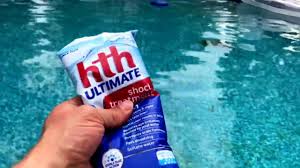
Shock and Oxidation Treatment
T
SHOCK/OXIDATION TREATMENT
Control of bather and other wastes is important for comfortable swimming. Wastes can build up and eventually corrupt the water. The best way to remove these wastes is with regular oxidation. The odor that is associated with combined chlorine is often mistakenly referred to as “too much chlorine in the water,” but actually indicates that there is too little. Shock oxidation treatment or super chlorination is needed to destroy these wastes. The term shocking means to add enough chlorine to pool or spa water to destroy all combined chlorine present in the water.
We use the phrase “shock oxidation treatment” when referring to the use of non-chlorine type shock-oxidizer. Conversely, the phrase “super chlorination” is used when referring to the use of a sudden large dose of chlorine. In either case, the goal is to destroy and remove bather waste in addition to preventing the formation of combined chlorine or the accumulation of irritating waste products.
SUPER CHLORINATION
Superchlorination products (such asCALCIUM HYPOCHLORIDE) produce free chlorine that reacts with organic contaminants to form a variety of disinfection byproducts (DBPs) which are hazardous to swimmer health e.g. one of the worst DBPs is the noxious and volatile trichloramine (NCl3), well known for irritating the eyes nearby a pool. It has been pointed out that ozone is an excellent alternative, a much more effective oxidizer than chlorine shock.
Super chlorination is effective in eliminating wastes or destroying combined chlorine. To achieve successful super chlorination, a single large dose of chlorine is applied to the water. Super chlorination actually works by first reacting with the organic wastes in the water to form more combined chlorine. Once a sufficient level of chlorine has been added, all of the organics will have been reacted with (oxidized), and only then will the combined chlorine break down leaving free chlorine. Typically, the amount of chlorine required is ten times the level of combined chlorine in the water. For example, if the chlorine test shows a level of 1.2 ppm of combined chlorine you will need to add 12 ppm of additional chlorine in order to destroy all of the combined chlorine. Chlorination also has a number of drawbacks, which include:
- requires a large amount of chlorine
- can damage liners and swimsuits
- upsets water balance
- difficult to determine proper dosage
- cannot swim until free chlorine level drops to 1-4 ppm
When using chlorine to destroy combined chlorine, failure to use a sufficient quantity will actually result in more combined chlorine, odor and irritation rather than less. The use of too much chlorine can cause the types of problems listed above.
SHOCK OXIDATION TREATMENT
Shock oxidation treatment is a phrase commonly used when referring to the use of a product that does not contain chlorine to eliminate wastes in the water. Instead, it uses a unique oxidizer to control wastes. (Must be compatible to your enzyme product or as a substitute for an enzyme). Most commonly referred to as “non-chlorine” shock, oxidizer it does not use chlorine to destroy the wastes, as the name implies. Non-chlorine shock uses an oxidizer that will directly oxidize the waste itself, whereas chlorine used in super chlorination works by first changing the waste into combined chlorine before final breakdown. Since non-chlorine shock oxidizer does not require chlorine, it can be used to destroy waste products before they have a chance to form combined chlorine, and it offers several significant advantages including:
- does not require excessive chlorine use
- will not harm liners or suits
- will not upset water balance
- easy to determine needed dosages
- can swim as soon as 15 minutes after treatment
Shock oxidation treatment or super chlorination should be administered at the start of the pool season. Frequency of application thereafter depends on several factors including: bather load, heavy rains or the presence of combined chlorine. Most residential pools should be shocked every week or two, while commercial pools should be treated at least weekly and more often if there is a heavy bather load or if the combined chlorine level is greater than 0.2 ppm.
Heavy rainfall also places a large amount of debris or organic material into pool water that can lead to combined chlorine or even algae growth. Shock oxidation treatment following a heavy rain will help in avoiding these problems. The best way to handle problems, including combined chlorine, is to prevent them from occurring. Non-chlorine shock oxidizers prevent the problem before it occurs. Super chlorination is most often used after the problems with combined chlorine become obvious.